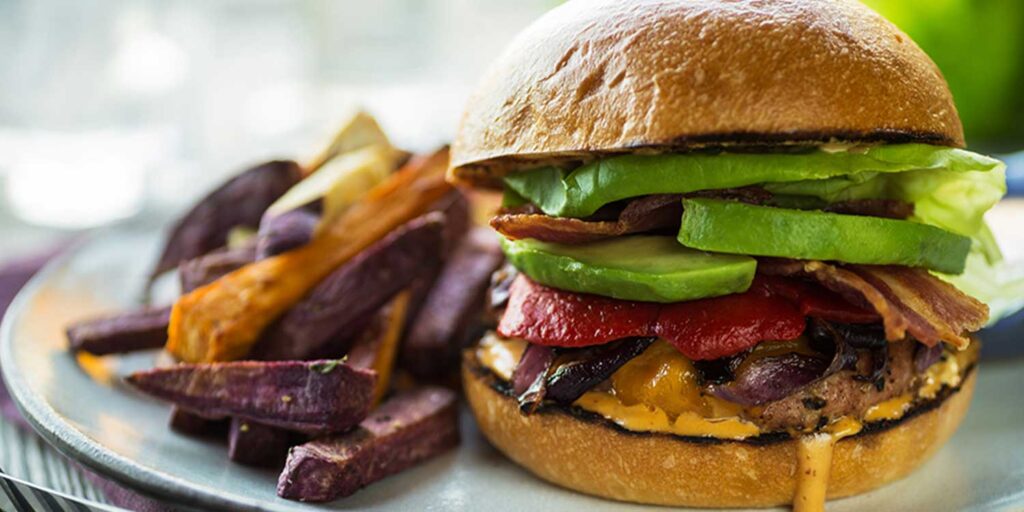
In the intricate tapestry of nutrition, the balance between macronutrients—protein, carbohydrates, and fats—serves as the cornerstone of achieving optimal health, fitness, and body composition. The art of strategic macronutrient distribution involves crafting a dietary blueprint that aligns with your goals, fuels your workouts, promotes muscle recovery, and supports overall well-being. In this comprehensive guide, we’ll delve into the intricacies of this balancing act and explore how the proper allocation of macronutrients can unlock your full potential.
The Role of Protein: Building Blocks of Strength
Protein, often hailed as the “building blocks of life,” holds a pivotal role in any successful nutrition plan. When striving for muscle growth, fat loss, or maintaining a healthy body, protein takes center stage.
Prioritize protein intake by allocating a higher percentage of your daily calories to this macronutrient. Protein supports muscle repair, growth, and maintenance, making it essential for individuals engaged in physical activities, especially strength training. Including lean sources of protein like chicken, fish, turkey, eggs, and plant-based options such as tofu and lentils provides the amino acids required for these critical functions.
Carbohydrates: The Fuel for Your Fire
Carbohydrates are your body’s primary source of energy, and their strategic distribution can significantly impact your performance, endurance, and recovery. Carbs are not the enemy—when utilized correctly, they are a powerful ally in achieving your fitness goals.
Allocate a moderate portion of your daily calorie intake to carbohydrates. These energy-providing nutrients fuel your workouts and help maintain glycogen stores in muscles, which are essential for sustained physical activity. Opt for complex carbohydrates like whole grains, fruits, vegetables, and legumes, as they provide a steady release of energy and support stable blood sugar levels.
Healthy Fats: Nurturing Hormones and Well-Being
Healthy fats, often misunderstood, play a vital role in hormone production, brain health, and overall well-being. Incorporating these fats into your diet can have far-reaching benefits beyond just aesthetics.
Assign a portion of your daily calorie intake to healthy fats, such as avocados, nuts, seeds, olive oil, and fatty fish like salmon. These fats are essential for absorbing fat-soluble vitamins (A, D, E, and K), maintaining healthy skin, and supporting brain function. By including a variety of sources, you ensure a diverse intake of beneficial fatty acids like omega-3s and omega-6s.
Customizing Your Distribution: Goals and Needs
The optimal distribution of macronutrients varies based on your individual goals, activity levels, metabolism, and preferences. Athletes aiming to build muscle may lean towards a higher protein intake, while endurance athletes might emphasize carbohydrates for sustained energy. Those on a weight loss journey might adjust their carbohydrate intake while preserving protein to prevent muscle loss.
Remember that flexibility is key. Your dietary blueprint should be adaptable to changes in your lifestyle and goals. Experiment with different macronutrient ratios and pay attention to how your body responds—energy levels, performance, and overall well-being are reliable indicators.
Macronutrient Distribution for Lean Muscle Gain
When focusing on gaining lean muscle mass, macronutrient distribution plays a critical role. In general, aiming for a balance of about 30% protein, 40% carbohydrates, and 30% fat can help support building muscle and losing fat. Here is a general guideline is as follows:
- Protein: Consume around 1.2 to 2.0 grams of protein per kilogram of body weight. Lean protein sources like chicken, fish, lean meats, eggs, dairy, and plant-based options like beans and tofu should be included in your diet.
- Carbohydrates: Allocate about 45-60% of your daily caloric intake to carbohydrates with most of your carbohydrates at breakfast and post-workout. Most other meals throughout the day will be around 40% or less. Opt for complex carbohydrates like whole grains, fruits, vegetables, and legumes to fuel your workouts and supplements that support muscle glycogen replenishment post-workout.
- Fats: Aim for about 20-30% of your daily caloric intake to come from healthy fats. Sources of healthy fats include avocados, nuts, seeds, olive oil, and fatty fish.
Remember that individual responses can vary, so adjustments based on progress and body responses are essential. Consult with a registered dietitian or nutrition professional for personalized guidance.
Achieving Lean Muscle Gain: A Holistic Approach
Gaining lean muscle mass requires a holistic approach that integrates proper macronutrient distribution, precise nutrient timing, and a balanced workout regimen. By mastering the art of balancing proteins, carbohydrates, and fats, you lay the foundation for achieving your fitness aspirations. Additionally, tailoring your nutrient intake to your goals, lifestyle, and preferences will enable you to sculpt a physique that reflects your hard work and dedication.
Remember that your journey to lean muscle gain is unique, and the proper macronutrient distribution will play a pivotal role in shaping your success story.

